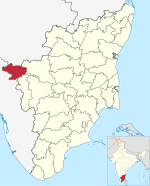Nilgiri Mountain Railway: Difference between revisions
206charlie (talk | contribs) m language edits in first two sections |
Rescuing 3 sources and tagging 0 as dead. #IABot (v1.6.2) (Iggy the Swan) |
||
| Line 179: | Line 179: | ||
===Television=== |
===Television=== |
||
In the UK, the BBC made a series of three documentaries<ref>{{cite web|url=http://www.bbc.co.uk/programmes/b00qzzlm#synopsis|title=Indian Hill Railways|publisher=BBC|accessdate=28 February 2010}}</ref> dealing with Indian Hill Railways, with the NMR being featured in the second programme shown in February 2010. (The first film covers the [[Darjeeling Himalayan Railway|Darjeeling-Himalayan Railway]] and the third the [[Kalka-Shimla Railway]].) The films were directed by Tarun Bhartiya, Hugo Smith and Nick Mattingly, and produced by Gerry Troyna. The series won the UK Royal Television Society Award in June 2010.<ref>{{cite web|url=http://www.expressindia.com/latest-news/documentary-on-hill-railways-of-india-bags-uk-award/636391/|title=Documentary on Hill railways of India bags UK award|publisher=Express India|accessdate=19 September 2010}}</ref> |
In the UK, the BBC made a series of three documentaries<ref>{{cite web|url=http://www.bbc.co.uk/programmes/b00qzzlm#synopsis|title=Indian Hill Railways|publisher=BBC|accessdate=28 February 2010}}</ref> dealing with Indian Hill Railways, with the NMR being featured in the second programme shown in February 2010. (The first film covers the [[Darjeeling Himalayan Railway|Darjeeling-Himalayan Railway]] and the third the [[Kalka-Shimla Railway]].) The films were directed by Tarun Bhartiya, Hugo Smith and Nick Mattingly, and produced by Gerry Troyna. The series won the UK Royal Television Society Award in June 2010.<ref>{{cite web|url=http://www.expressindia.com/latest-news/documentary-on-hill-railways-of-india-bags-uk-award/636391/|title=Documentary on Hill railways of India bags UK award|publisher=Express India|accessdate=19 September 2010|deadurl=yes|archiveurl=https://web.archive.org/web/20121010101221/http://www.expressindia.com/latest-news/documentary-on-hill-railways-of-india-bags-uk-award/636391/|archivedate=10 October 2012|df=dmy-all}}</ref> |
||
==Gallery== |
==Gallery== |
||
| Line 210: | Line 210: | ||
* [http://indiasteam.tripod.com/nmr.htm Images and info] |
* [http://indiasteam.tripod.com/nmr.htm Images and info] |
||
* [http://www.thehindubusinessline.com/life/2005/09/16/stories/2005091600080200.htm Toy train chugs on ] |
* [http://www.thehindubusinessline.com/life/2005/09/16/stories/2005091600080200.htm Toy train chugs on ] |
||
* [http://twins.free.fr/travel/photos%20inde/page%202/pages/train%20ooty%202_jpg.htm Udhagamandalam train Photographs] |
* [https://web.archive.org/web/20060518223119/http://twins.free.fr/travel/photos%20inde/page%202/pages/train%20ooty%202_jpg.htm Udhagamandalam train Photographs] |
||
* [https://web.archive.org/web/20110720104926/http://deepsan.livejournal.com/93336.html 20 photos between Udhagamandalam and Coonoor] |
* [https://web.archive.org/web/20110720104926/http://deepsan.livejournal.com/93336.html 20 photos between Udhagamandalam and Coonoor] |
||
* [http://www.hindu.com/yw/2005/07/29/stories/2005072900030100.htm The toy train chugs on] |
* [http://www.hindu.com/yw/2005/07/29/stories/2005072900030100.htm The toy train chugs on] |
||
* International Working Steam [http://www.steam.dial.pipex.com/internat.htm] |
* International Working Steam [https://web.archive.org/web/20070609212632/http://www.steam.dial.pipex.com/internat.htm] |
||
{{Tourism in The Nilgiris}} |
{{Tourism in The Nilgiris}} |
||
Revision as of 12:44, 21 January 2018
This article may require copy editing for grammar, style, cohesion, tone, or spelling. (July 2017) |
| Nilgiri Mountain Railway | |
|---|---|
 NMR at Ketti station | |
| Terminus | Udhagamandalam |
| Preserved operations | |
| Operated by | Southern Railway |
| Stations | 13 |
| Length | 46 km |
| Preserved gauge | 1,000 mm (3 ft 3+3⁄8 in) |
| Commercial history | |
| Opened | 1908 |
| Preservation history | |
| Hauptsitz | Mettupalayam |
The Nilgiri Mountain Railway (NMR) is a 1,000 mm (3 ft 3+3⁄8 in) metre gauge railway in Tamil Nadu, Indien, built by the British in 1908.[1] The Railway is operated by the Southern Railway.[2] NMR is the only rack railway in India.
The railway relies on its fleet of steam locomotives.[3] For the past several years, NMR has used diesel locomotives instead of steam locomotives on the section between Coonoor and Udhagamandalam. Local people and tourists have led a campaign to return to the use of steam locomotives in this section.[3]
In July 2005, UNESCO added the Nilgiri Mountain Railway as an extension to the World Heritage Site of Darjeeling Himalayan Railway. The site then became known as Mountain railways of India.[4].[5]
History
This section needs expansion. You can help by adding to it. (July 2017) |
The British began construction of NMR in 1908. Initially, Coonoor was the final station on the line. In September 1908 NMR extended to Fernhill. By October 15, 1908, NMR extended to Udagmandalam .
-
A curve on NMR
-
A curve on NMR
-
Railway bridge between Coonoor and Udhagamandalam in the 1870s
-
NMR line showing rack and pinion in 1900
Operators
The NMR and all its movable and immovable assets, including the authentic railway stations, the line, and the track vehicles, belong to the Government of India and are entrusted to the Ministry of Railways. The Southern Railway performs the day-to-day maintenance and management but several programs, divisions and departments of the Indian Railways are responsible for operating, maintaining and repairing the NMR. This includes technical as well as non-technical work.
Rack and pinion
Between Mettupalayam and Coonoor, the line uses the Abt rack and pinion system to climb the steep gradient. Thus NMR is the only rack railway in India.
-
Functioning of the rack and pinion
-
Rack seen between the two tracks
-
Start of the rack after Kallar
Rolling stock
NMR uses 'X' Class steam rack locomotives, manufactured by the Swiss Locomotive and Machine Works of Winterthur in Switzerland, on the rack and pinion section of its tracks. The X Class locomotives are six to eight decades old. These locomotives have given NMR a distinct charm, taking scores of passengers to Coonoor and Udhagamandalam, covering 45.8 kilometres (28 mi), 108 curves, 16 tunnels and 250 bridges.
The steam locomotives can be used on any part of the line (either with or without the rack section), but the newer diesel locomotives can operate only on the section between Coonoor and Udagamandalam. This signals the beginning of the process to phase out the coal-fired vintage Swiss engines.
Hence, the Southern Railway decided to replace the coal-fired locomotives. The work was entrusted to Golden Rock Workshop of Southern Railway at Tiruchirapalli.
Each new engine weighs a little over 50 tonnes and cost Rs.10 crore. The new engines have pilot and primary burners. Separate tanks hold about 850 litres (190 imp gal; 220 US gal) of diesel and 2,250 litres (490 imp gal; 590 US gal) of furnace oil. The hauling capacity of this new engine is 97.6 tonnes (96.1 long tons; 107.6 short tons). It can run at a speed of 30 kilometres per hour (19 miles per hour) on plains and at 15 kilometres (9.3 miles) an hour on a gradient. The arrival of the new engines eliminated the disruptions in service that occurred frequently over the last few years.
The steam locomotives are always marshalled at the downhill (Mettupalayam) end of the train. The average gradient in this rack section is 1 in 24.5 (4.08%), with a maximum of 1 in 12 (8.33%). Between Coonoor and Udagamandalam, the train is operated by a YDM4 diesel locomotive using conventional rail adhesion principles. On this section, the locomotive is always at the Coonoor end of the train as although the line is not steep enough to need a rack rail, the ruling gradient out of Coonoor is still very steep at 1 in 25 (4%).
Southern Railway carries out the majority of the locomotive repairs at the Coonoor shed but has rebuilt many of the steam locomotives at the Golden Rock Workshops. Many carriage repairs take place at Mettupalayam. Like the locomotives, major work on the carriages takes place at one of the larger railway workshops.
Route
| ||||||||||||||||||||||||||||||||||||||||||||||||||||||||||||||||||||||||||||||||||||||||||||||||||||||||||||||||||||||||||||||||||||||||||||||||||||||||||||||||||
The 'Nilgiri Passenger' train covers a distance of 26 km (16.2 mi),[3] travels through 208 curves, 16 tunnels,[3] and across 250 bridges.[3] The uphill journey takes around 290 minutes (4.8 hours), and the downhill journey takes 215 minutes (3.6 hours). It has the steepest track in Asia with a maximum gradient of 8.33%.[3]
As of 2007, there is one train a day over the rack section, which starts from Mettupalayam at 07:10 and reaches Udhagamandalam at noon. The return train starts from Udhagamandalam at 14:00, and reaches at 17:35. The train is scheduled to connect to the Nilgiri Express, which travels from Mettupalayam to Chennai via Coimbatore. A summer special service is also run during the months of April and May, starting from Mettupalayam at 09:30 (AM) and from Udhagamandalam at 12:15 (PM). Between Coonoor and Udagamandalam, there are four daily trains each way.
Even though the NMR stations have networked computerised ticketing systems for onward journeys, it still issues Edmondson style manual tickets for the Udhagamandalam-Mettupalayam journey to preserve the 'World Heritage Site' status of the railway. However, ticket booking is similar to other conventional trains and can also be done via the Indian Railways' website. It is advisable to book tickets for this railway well in advance, especially during peak season.
Stations
Station with the 5 ft 6 in (1,676 mm) line near to Coimbatore Junction. Passengers cross the platform to board the Nilagiri Passenger train (NMR). There is a small locomotive shed here and also the carriage workshops for the line. Leaving Mettupalayam, the line is adhesion worked and actually drops for a short distance before crossing the Bhavani River, after which it starts to climb gently.
- Kallar Station
Closed as a passenger station, this is where the rack rail begins. As the train leaves the station, the gradient is 1 in 12 (8.33%).
- Adderly Station
Closed as a passenger station but is still a water stop.
- Hillgrove Station
Block post and water stop also have refreshments for passengers.
- Runneymede Station
Closed as a passenger station but is still a water stop.
- Kateri Road Station
Closed as a passenger station, trains do not stop here.
Main intermediate station on the line at the site of the locomotive workshops as well as the top end of the rack rail. Trains must reverse a short distance before continuing their climb to Udhagamandalam. It is normal for the locomotive to be changed here with diesel traction, being normal for all trains to Udhagamandalam.
From a short distance before Lovedale, the line descends into Udhagamandalam.
Udhagamandalam railway station has preserved much of its equipment from the railway heyday of the Raj. In addition to the original 1908 building, it still has an operational water dispenser for steam locomotives, and a weighing scale made in 1907 by Hendry Boomley & Son of Birmingham.[6]
-
Mettupalayam railway station
-
Hillgrove railway station
-
Coonoor railway station
-
Wellington railway station
-
Aruvankadu railway station
-
Ketti railway station
-
Lovedale railway station
-
Udhagamandalam railway station
In popular culture
Film
Coonoor station was one of two used as locations in David Lean's film A Passage to India.[7] You can also see Coonoor station and its heritage locomotive in many of the Indian films. Wellington station always finds a place in most of the films casting the Indian army or army training storyline mainly due to the MRC Indian Army Regiment, Defence Services Staff College, the Cantonment and the Cordite Factory. Ketti station was used as the location in a Malayalam film Summer in Bethlehem. Lovedale station is very picturesque and has featured in many popular films including the famous Tamil hit, Moonram Pirai. The famous Hindi song Chaiyya Chaiyya from the film "Dil Se.." featuring Shahrukh Khan & Malaika Arora Khan was shot on the rooftop of NMR. Udhagamandalam station has featured in many of the Tamil and other South Indian language films. It is also prominently featured in some of the Bollywood films. One of the X Class locomotives on the Nilgiri Mountain Railway is modelled for Ashima in the film Thomas & Friends: The Great Race.
Television
In the UK, the BBC made a series of three documentaries[8] dealing with Indian Hill Railways, with the NMR being featured in the second programme shown in February 2010. (The first film covers the Darjeeling-Himalayan Railway and the third the Kalka-Shimla Railway.) The films were directed by Tarun Bhartiya, Hugo Smith and Nick Mattingly, and produced by Gerry Troyna. The series won the UK Royal Television Society Award in June 2010.[9]
Gallery
-
A still from the documentary on NMR.[10]
-
NMR train
-
Nilgiri Queen Crosses a River
-
Rack track near Coonoor
-
Cog-drive truck
-
An old steam locomotive plinthed at Udhagamandalam
-
NMR plaque
-
An Edmondson-style ticket
See also
References
- ^ "Mountain Railways of India". UNESCO. Retrieved 1 March 2010.
- ^ citation needed
- ^ a b c d e f Indian Hill Railways: The Nilgiri Mountain Railway (TV). BBC. 21 February 2010. Retrieved 1 March 2010.
- ^ NMR added as a World Heritage Site
- ^ "Mountain Railways of India". UNESCO World Heritage Centre. Retrieved 30 April 2006.
- ^ "Not scarred by time, Udhagamandalam station retains its heritage history". The Times of India. 24 November 2016. Archived from the original on 27 November 2016.
{{cite news}}: Unknown parameter|deadurl=ignored (|url-status=suggested) (help) - ^ http://www.mapability.com/travel/p2i/coonoor.html
- ^ "Indian Hill Railways". BBC. Retrieved 28 February 2010.
- ^ "Documentary on Hill railways of India bags UK award". Express India. Archived from the original on 10 October 2012. Retrieved 19 September 2010.
{{cite web}}: Unknown parameter|deadurl=ignored (|url-status=suggested) (help) - ^ https://www.youtube.com/watch?v=VubpqN_6LWQ
Notes
- Book: NMR-FROM LIFELINE TO OBLIVION by V.M. Govind Krishnan






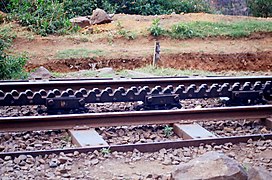
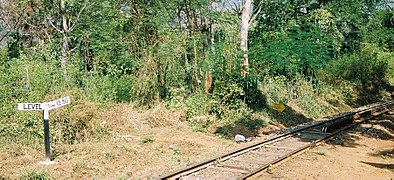
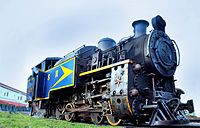


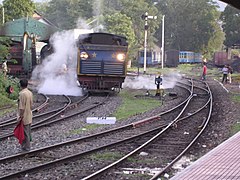

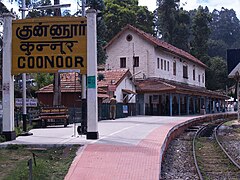
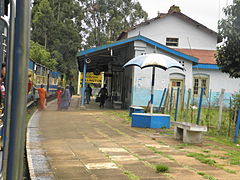

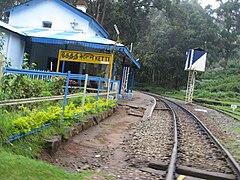
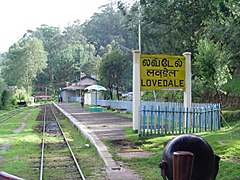

![A still from the documentary on NMR.[10]](http://upload.wikimedia.org/wikipedia/commons/thumb/7/72/Nilgiri_Mountain_Railway.jpg/301px-Nilgiri_Mountain_Railway.jpg)









